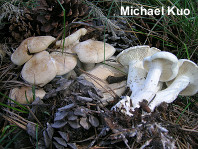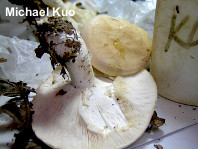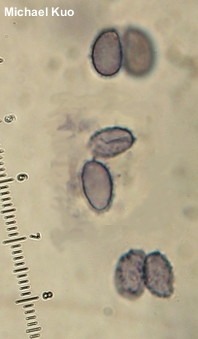|
The Genus Leucopaxillus 
[ Basidiomycota > Agaricales > Tricholomataceae . . . ]
by Michael Kuo
At a foray in the Midwest, examining my collections from the day, I pulled a messy clump of mushrooms and leaves out of my basket. The leaves were everywhere, attached to the stems of the mushrooms by tenacious white mycelium, and when I set two mushrooms out the leaves and mycelium covered several square feet of the tabletop. A mycologist walking by said casually, "That's a saprobe."
Get it? That's a saprobe! Yes, believe it or not, that was a joke, and we both had a good chuckle—which probably tells you something about people who spend all their time poking at mushrooms. But the source of the humor (go ahead and put that word in quotation marks if you want) was that, rather than identifying the mushrooms, he had stated the obvious; the presence of all those mycelium-bound leaves could only mean the mushrooms were saprobic and, more specifically, were litter-decomposing saprobes, so focused on their task that they could not let go of the leaves even when picked.
The mushrooms were a species of Leucopaxillus, and the copious litter-binding mycelium is one of several defining features for the genus. Other features include:
- The dry, smooth or finely velvety cap that often features an inrolled margin when young;
- White to yellowish gills that are attached to the stem or run down it and are separable as a layer (see the illustration);
- The absence of a partial veil;
- The white spore print;
- The amyloid, spiny spores.
In addition, many Leucopaxillus species have a mealy or "coal tar" odor, and many taste bitter. Several species are highly resistant to decay and will last for weeks in dry weather. Species of Leucopaxillus are distributed across North America, from boreal to subtropical areas, and are found in a wide variety of forest types.
|
|



|
Traditionally, identification in Leucopaxillus relies on careful observation of physical features that can be seen with the naked eye, with occasional reference to microscopic features. Mycological giants Rolf Singer and Alexander Smith monographed the genus in 1943, describing about two dozen species, varieties, and forms worldwide. Since then, some names have shifted around and new species have been described (especially from tropical areas), but the Leucopaxillus story for North America has not been substantially revised.
Particularly troublesome is the "Leucopaxillus albissimus" complex, and field guide authors have published widely different accounts of this taxonomic area. My approach (see couplets 5 and 6 in the key below) is to de-emphasize the highly variable color of the cap in this complex and refer, instead, to geographic range and ecology—but I readily concede the possibility that I am wrong. Perhaps there is one highly adaptive and cosmopolitan species demonstrating physical differences in response to environmental factors; perhaps there are several species whose physical differences do not predict their genetic separation; perhaps the traditional arrangement is dead-on.
Several contemporary, DNA-informed studies (Vizzini et al. 2012, Sánchez-García et al 2014, Vizzini et al. 2016) have supported the idea that Leucopaxillus is a well-defined genus, closely related to Tricholoma and Porpoloma, but an in-depth, species-level study of many North American collections has not been done, to my knowledge.
Key to 7 Leucopaxillus species in North America 
| 1. | Cap up to 45 cm or more across, white at first but often developing brownish colors with age; possibly widespread but most commonly found in the Pacific Northwest and the Rocky Mountains; spores weakly amyloid, smooth. | Leucopaxillus giganteus |
| 1. | Cap smaller than above, variously colored; variously distributed; spores strongly amyloid, spiny. | 2 |
| 2. | Tropical to subtropical in distribution; cap small (to about 5 cm across), blood red when fresh and young; stem slender (to about 6 x 1 cm). | Leucopaxillus gracillimus |
| 2. | Variously distributed; cap usually larger than above, never blood red; stem usually stockier than above. | 3 |
| 3. |
Under hardwoods east of the Rocky Mountains; cap and stem both yellow; stature Clitocybe-like; taste not distinctive; rare. | Leucopaxillus subzonalis
= Leucopaxillus pulcherrimus |
| 4. | Under hardwoods in eastern North America; cap yellow to buff or brownish, with a yellowing margin; stature stocky; gills yellow or yellowish; odor foul, like coal tar; gills becoming purple-red to purplish pink when dried; mushroom somewhat reminiscent of Tricholoma odorum. | |
| 4. | Not as above (Leucopaxillus albissimus complex). | 5 |
| 5. | Under conifers in western North America; young cap liver brown. | |
| 5. | Under conifers or hardwoods across North America; cap variously colored but not liver brown when young. | 6 |
| 6. | Mycelium binding the debris of conifers; a majority of spores usually longer than 5.5 µ (including ornamentation); gills usually close; stature often somewhat stocky. | |
| 6. | Mycelium binding the debris of hardwoods; spores usually under 5.5 µ long; gills usually crowded; stature not usually stocky. | |
References
Sánchez-García, M., P. B. Matheny, G. Palfner & D. J. Lodge (2014). Deconstructing the Tricholomataceae (Agaricales) and introduction of the new genera Albomagister, Corneriella, Pogonoloma and Pseudotricholoma. Taxon 63: 993–1007.
Singer, R. & Smith, A. H. (1943). A monograph on the genus Leucopaxillus Boursier. Papers of the Michigan Academy of Science 28: 85–132.
Singer, R. & Smith, A. H. (1947). Additional notes on the genus Leucopaxillus. Mycologia 39: 725–736.
Vizzini, A., E. Ercole & M. Contu (2012). A contribution to the ITS-LSU phylogeny of the genus Leucopaxillus (/tricholomatoid clade, Agaricales), with three new genera and notes on Porpoloma. Mycosphere 3: 79–90.
Vizzini, A., G. Consiglio, E. Ercole & L. Setti (2016). Pseudoporpoloma, a new genus for Agaricus pes-caprae (Agaricales, Tricholomataceae). Phytotaxa 243: 271–280.
This site contains no information about the edibility or toxicity of mushrooms.
Cite this page as:
Kuo, M. (2017, November). The genus Leucopaxillus. Retrieved from the MushroomExpert.Com Web site: http://www.mushroomexpert.com/leucopaxillus.html
© MushroomExpert.Com
|



